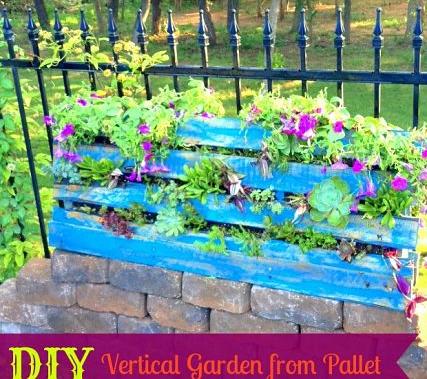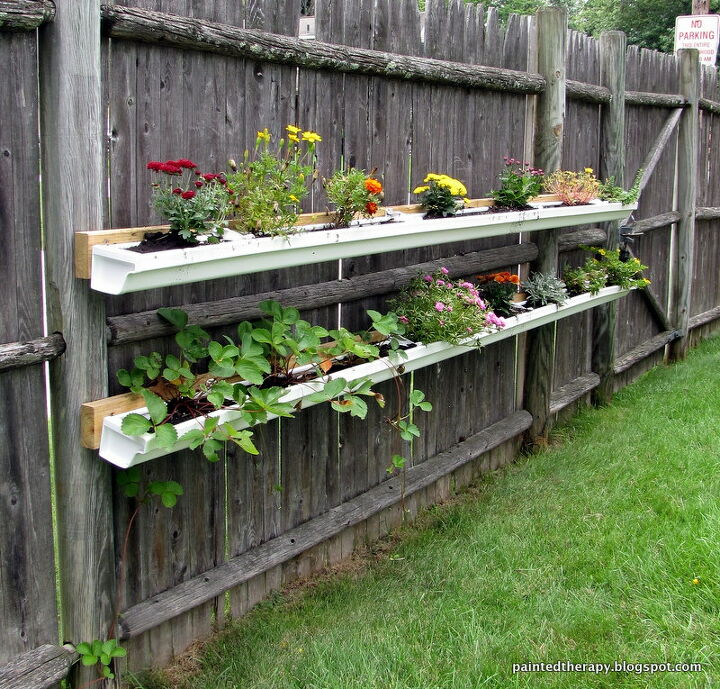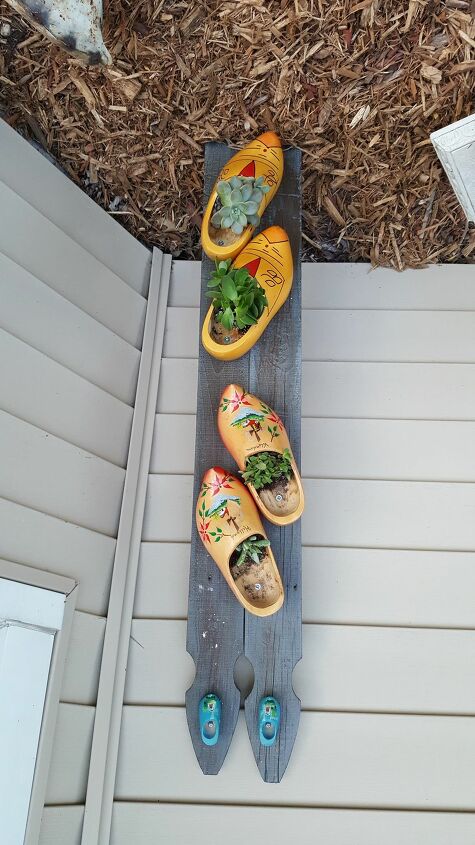14 Creative Ways to Plant a Vertical Garden & Maximize Space
Vertical gardens not only take up less space, but they are also generally easier for novices to harvest and maintain. Creating a DIY vertical garden can be as simple or as complex as you see fit. Vertical garden ideas are all about creating features that are a feast for the eyes, from vibrant colours to tempting textures. Here are several ways you can create a DIY vertical garden and make it into your own little oasis.
Create a Backdrop of Hanging Pots Using a Vertical Pallet Garden
One of the most inexpensive ways to create a focal point for your outdoor living space is to acquire used pallets as a secure backdrop for planters, or even as a planter itself. Pallets are often used to transport sizeable, heavy objects and you may even have some already for past deliveries such as bathroom suites and kitchens. This pallet has been painted a striking blue before being filled with potting soil between the pallet planks right to the top, ready for planting. Hand-pick a range of plants such as succulents and petunias to create a magnificent waterfall backdrop. Get tutorial here
Use Chicken Wire to Make a Bright and Airy Vertical Garden Backdrop
Affixing hard-wearing chicken wire to a wooden frame can create an excellent backdrop and a sturdy place for hanging terracotta pots. If you want an outdoor vertical garden without compromising external views, chicken wire can achieve this brilliantly. Just be careful not to use pots that are too large, so that you don't bend the wire and ruin its symmetrical appearance. The example above shows just how effective chicken wire can be for growing vegetables such as snap peas. Get tutorial here
Repurpose Old Guttering for Herbs and Planters
If you are replacing your home’s guttering in the near future, remember that it can find a new use as part of your new vertical garden before you take it to the recycling center. By affixing rows of guttering to a garden wall, you can create ample space for plants and herbs to grow. Just be sure to leave enough room between each row of guttering to allow for sufficient levels of sunlight to reach them. Make use of rainwater by drilling holes within each row of guttering so that the lowest rows receive adequate water and the top levels don’t become waterlogged. Shallow root plants will thrive best in guttering. Get tutorial here
Create a Striking Vertical Garden out of Plastic Bottles
A great way of making use of empty bottles of drink is to use them to create eye-catching plastic towers full of plants. Cut slits into the sides of each bottle to give your new plants enough room to sprout outside of the bottles, and stack the bottles on top of each other. You could also fix climbing plants to one of the plastic towers to provide stability. Leave the top of each plastic tower open to the elements, so that the plants can receive regular rainwater. Doing so also makes them easy to water using a watering can. These towers can be used to border small areas of decking or patio, making it feel more enclosed and private. Get tutorial here
Use Recycled Florafelt to House Root-Wrapped Plants
Florafelt is made out of recycled plastics, so it is helping to keep plastic out of landfill while creating a beautiful feature for your garden. These lightweight Florafelt pockets can be attached to a fence or wall to create low-maintenance living wall systems with plants placed within each little pouch, as above. Root wrappers are provided in each pouch, making it easy to rearrange the look and feel of your plants. Some people use digital hose timers to provide twice daily watering for all pouches, for ease of mind. Get tutorial here
Repurpose an Old Wooden Ladder to Make a Vertical Garden Statement
If you happen to have an old wooden ladder lying around in the garage, you could use it to create your new vertical garden. This wooden ladder featured above now works as a freestanding vertical garden structure, allowing the homeowner to place pots and plants at various levels, creating a feast for the eyes. If you do have some spare wood left over from other DIY projects, you could always fix a small raised bed to the bottom step. This again could be used as a vertical herb garden or as a means of bordering a patio area to create a greater sense of seclusion. Get tutorial here
Turn Old Structures Into an Eye-Catching Vertical Garden System
If you’ve learned one thing so far from this guide, it’s that there is always another use for something – even old staircases and ladders! A stair garden can create a stepped vertical garden system that’s just the right size for plant beds. The fact that it’s stepped also makes for an effective way to ensure excess rainwater can run off down the unit onto the lower levels and the floor. You can re-varnish or stain your old staircase to give it a new lease of life too. Get tutorial here
Organize Your Plants With Unused Clogs
Even unused shoes such as Dutch clogs can make for the perfect vertical garden façade. Simply affix your wooden clogs to a fence or wall and fill each clog with soil, ready for your plants. It works in much the same way as the Florafelt. This is another responsible way of minimizing the refuse that you send to landfill, while creating more fun, green spaces in your home to enjoy. Get tutorial here
Choose Succulents and Other Species That Are Easy to Care For
This tip isn’t strictly about physically building an outdoor vertical garden, but it can help ensure the longevity of your vertical garden system. Be selective over the plants you choose to keep it as low-maintenance as possible. Succulents are generally the easiest plants to look after. These generally require watering once a week, which should be achievable for those with even the most demanding work schedules. Be mindful that herbs and geraniums will need watering three to four times a week, particularly in the warmer months Get tutorial here
Hanging Indoor Vertical Gardens Made from Recycled Flooring
This tip is geared towards urban dwellers in flats and apartments keen to transform an unused wall to an oasis of tranquility. Hometalker ToolBox Divas makes it look easy to put together these indoor vertical garden beds that are hung together to create the ideal location for a productive herb garden. You can even label each planter to make it easy to grab the herbs you need when you're in your element, cooking. Get tutorial here
Create a Vertical Vegetable Garden Using a Grid Trellis
This hugely effective grid trellis doubles up as a vertical garden and a source of shade for patio areas in the summer months. All that's needed is a basic trellis from your typical hardware store and some hanging planters and it's possible to create an instant herb and flower garden for even the most modest of outdoor spaces. Combine this with some outdoor seating and you've got yourself an instantly characterful patio area. Not only do the plants and herbs look beautiful, but the trellis also adds a layer of symmetry that's aesthetically pleasing. Get tutorial here
Turn Your Balcony Into a Fruit and Veg Haven with a DIY Vertical Garden
Ideal for those short on floor space, create a DIY frame that can be fixed to your flat or apartment balcony. The frame can then house a range of pots with anything from dwarf tomatoes and fresh herbs bedded in. The raised bed in the lower planter would make for the ideal spot for some juicy seasonal strawberries. If you have a balcony that gets plenty of sunshine, this kind of DIY vertical garden would greatly enhance your everyday life, generating fresh homegrown produce. Get tutorial here
Paint a Wood Pallet to Create a Visually Striking Rainbow Vertical Planter
We’ve already discussed how a wood pallet can create new vertical garden systems, but this image demonstrates just how creative you can get with a pallet. Crystal Allen's rainbow vertical planter has helped transform her backyard into a colorful oasis. It's something that all the family can get involved with coloring using acrylic paints and a little imagination. It goes to show that outdoor vertical gardens can be just as pretty as they are practical. Get tutorial here
Dress up a Living, Breathing Wall of Leaves
Do you suffer from an ugly fence or garden wall? Why not plant flowers and climbers all over the entire fence or wall to enjoy a living, breathing wall of plants? Even in high-density areas, urbanites can grow far more than you might imagine upwards. Living walls are particularly popular among landscapers that enhance the beauty of properties and help to clean the outside air. Get tutorial here













